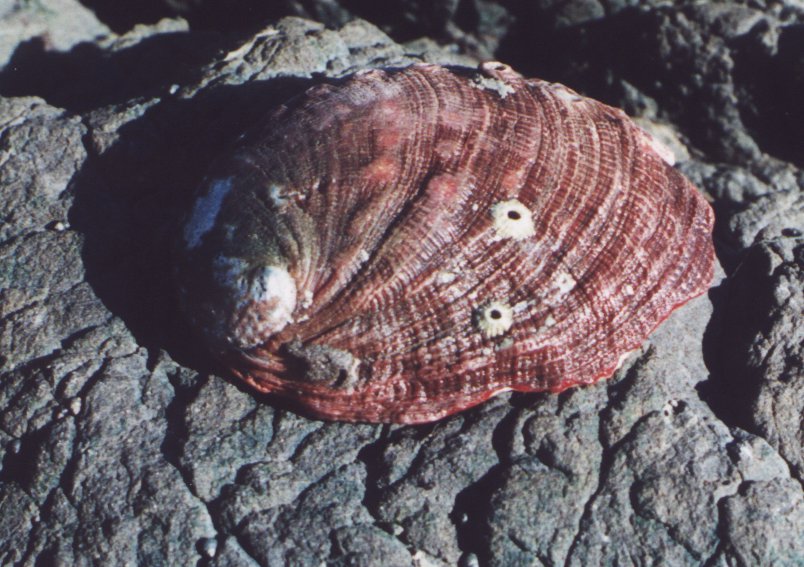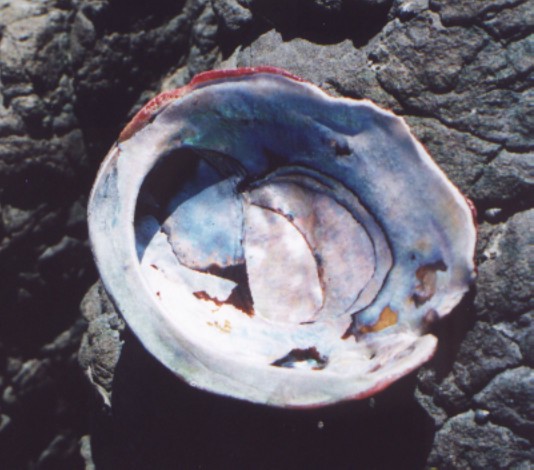Haliotis rufescens Swainson, 1822Common name(s): Red abalone |
|
| Synonyms: |  |
| Phylum Mollusca
Class Gastropoda Subclass Prosobranchia Order Archaegastropoda Suborder Pleurotomariina Family Haliotidae |
|
| Shell of Haliotis rufescens, 15 cm long, from San Simeon, CA | |
| (Photo by: Dave Cowles April 1995) | |
How to Distinguish from Similar Species: No other local abalone grows as large as this one. Any abalone above about 15 cm is unlikely to be another species. Haliotis kamtschatkana (Japanese abalone) has a thinner shell without a prominent muscle scar. Haliotis cracherodii (black abalone) has a smooth black shell. H. walallensis has spiral ridges on the shell, no muscle scar, and its shell is small (to 12-15 cm), reddish, with pale green, blue, or white mottling. Note: Abalones often hybridize. In southern California this species hybridizes with H. sorensoni, H. corrugata, and H. kamtschatkana; and rarely with H. walallensis.
Geographical Range: Central British Columbia to Baja California; uncommon north of Monterey. Abalones are much less common all along the Pacific coast than they were in years past, most likely because of harvesting by humans.
Depth Range: Intertidal to over 180 meters depth; primarily subtidal and most abundant from 20 to 40 m depth (6 to 17 m off CA)
Habitat: Primarily subtidal, + some lower intertidal on inaccessible rocky, wave-swept areas of the open coast. Found especially on the underside of overhanging ledges.
Biology/Natural History: This abalone can grow to larger size than any other abalone in this area. Abalones are algae grazers; mostly on microalgal films on the rocks though adults also capture pieces of kelp with their foot and consume them. The red color in the shell comes from rufescine; which is similar to the phycoerythrin found in red algae. If the abalone has been feeding primarily on brown algae the shells are aquamarine, green, or white instead of red. A diet alternating between red and brown may give a banded shell. Boring sponges (Cliona celata) often inhabit the older portions of the shell. The small boring clam Penitella conradi may bore into the shell from the outside, causing the abalone to secrete an extra blister of nacre inside to keep the clam from bursting through. The tissue of the foot is often iridescent, and the tentacles are black. This species becomes sexually mature at 6 years, and may live for 20 years. They spawn throughout the year, especially February to April. A large female may have over 12 million ripe oocytes. The veliger larvae are induced to settle by compounds released from coralline algae, jpon which the young abalones graze. This species is commercially the most important, and is commonly served in restaurants. They are also prized by otters, rock crabs Cancer antenarius, octopus, and the seastars Pycnopodia helianthoides and Pisaster ochraceous. They exhibit an galloping, zigzag escape response from predatory seastars, with the upper part of the foot extended over the edge of the shell. Adult abalones occupy a home scar and do not range far. Fossils of abalone are found in Cretaceous strata. They exist in several oceans but grow to largest size in the Pacific. The swimming veliger larvae chew on coralline algae, which releases GABA (gamma-aminobutyric acid). This chemical induces the veligers to settle and metamorphose into juveniles. The abalone scrapes only the surface off the coralline algae, so it actually benefits the algae by removing fouling epiphytes. The animal obtains a red dye (rufescin) from the algae, which it incorporates into its shell for the pink color. The color probably helps camouflage the abalone from predators such as octopus.
| Return to: | |||
| Main Page | Alphabetic Index | Systematic Index | Glossary |
References:
Dichotomous Keys:Allen, 1976
Flora and Fairbanks, 1966
Kozloff 1987, 1996
Smith and Carlton, 1975
General References:
Brandon
and Rokop, 1985
Brown
and Rovetta, 1996
Brusca
and Brusca, 1978
Gotshall,
1994
Gotshall
and Laurent, 1979
Harbo,
1997
Hinton,
1987
Kozloff,
1993
McConnaughey
and McConnaughey, 1985
Morris,
1966
Morris
et al., 1980
Niesen,
1994
Niesen,
1997
O'Clair
and O'Clair, 1998
Ricketts
et al., 1985
Snyderman,
1988
Scientific Articles:
General Notes and Observations: Locations, abundances, unusual behaviors:

The underside of the above individual. Note the pearly interior of the shell.
Photo by Dave Cowles at San Simeon, CA, April 2005
Authors and Editors of Page:
Dave Cowles (2005): Created original page